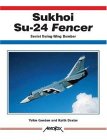| Country of Origin | CIS (Commonwealth of Independent States). |
|---|---|
| Similar Aircraft | Tornado, F-111, F-14 Tomcat, F-15 Eagle, MiG-23/-27 Flogger. |
| Crew | Two. |
| Role | All-weather attack, fighter-bomber, strike. |
| Armament | Cannon, missiles, bombs. |
| Dimensions | Length: 69 ft, 6 in (20 m). Span: 56 ft, 6 in (17.26 m). |
Su-24 Fencer WEFT Description
| Wings | High-mounted, variable, swept-back, and tapered. |
|---|---|
| Engine(s) | Twin turbofans. Air intakes are tapered away from the body, rectangular-shaped, and mounted on the body forward of the wings�’ leading edges. Twin exhausts. |
| Fuselage | Long, slender, with pointed, solid nose, and rectangular-shaped body from the air intakes to the exhausts. Two belly fins; four pylons. Bubble canopy. Dorsal spine extends from the cockpit to the tail. |
| Tail | Fin swept-back and tapered with square tip. Flats are high-mounted on the fuselage, swept-back, and tapered with angular tips. |
Countries which Fly the Su-24 Fencer
Azerbaijan, Belarus, CIS (Commonwealth of Independent States), Iran, Kazakhstan, Libya, Syria, Ukraine.
Su-24 Fencer Manufacturer Web Site
Books on the Su-24 Fencer

Sukhoi Su-24 Fencer: Soviet Swept-Wing Bomber
The Fencer, with its distinctive three-position variable-geometry wings, is the Soviet counterpart to the American F-111, though somewhat smaller and lighter, and to a lesser extent the Tornado. Its origins certainly owed a lot to Soviet observation of the American TFX competition and the resulting swing-wing variable-geometry solutions. First flown in 1971, it entered service from 1974 as a replacement for the Yak-28 and remains an important part of the Russian VVS inventory, with severa hundred having been in service. It is able to carry a wide range of air-to-surface missiles and is capale of carrying out precision attacks in hostile airspace at night or during poor weather. Much larger and more capable than previous Soviet aircraft, it combines great penetrative ability with a heavy and varied bomb load, but is sucha versatile airframe that it has also been developed in various other versions including tactical bomber, electronic warfare, and reconnaissance. As usual with the Aerofax series, this book includes extensive dtail of systems, equipment, weapons, etc., and a plethora of previously unpublished photographs and drawings.
